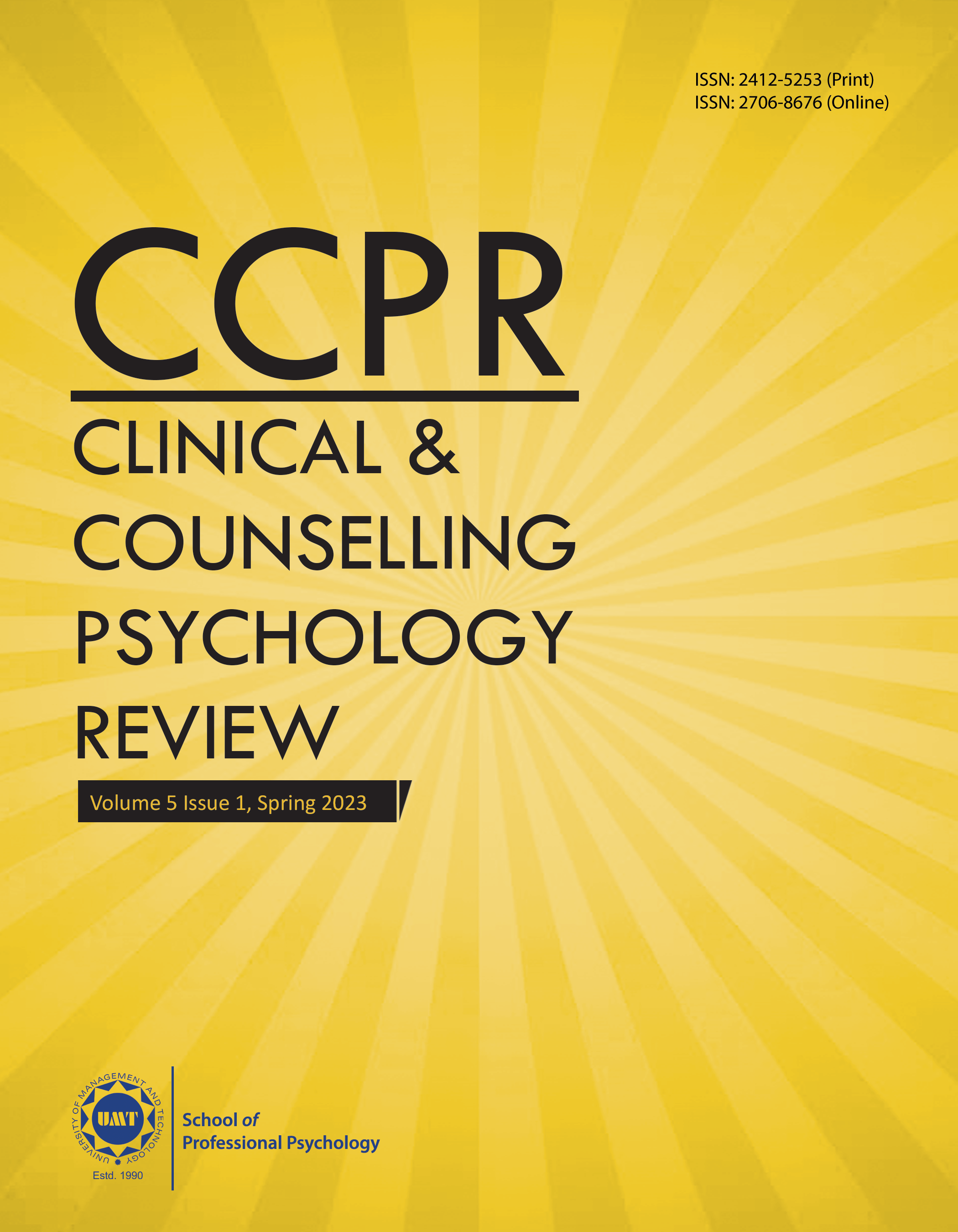Developing Phoneme Performance Using ABA: A Case Study
Abstract
 Abstract Views: 0
Abstract Views: 0
Phoneme awareness is vital for student development and academic success. It involves understanding sounds and patterns in spoken language, which is crucial for language proficiency and literacy acquisition. The child E. A 9-year-old girl was a student of 4th grade. She came with the presenting complaints of a lack of interest in studies and being unable to learn long questions (difficulty reading and writing in Urdu and English). The assessment was done and a management plan was formed. The assessment was conducted through behavioral observation, clinical interviews with the teacher and client, subjective ratings of the presenting complaints, Digit Span, Vocabulary tests from Cognitive Assessment Battery (CAB), and curriculum-based assessment. The result of the assessment showed that the child had academic issues like poor phoneme awareness (unable to identify a few phonemes, issue in blending letters, etc.) and a lack of interest in studies. For the current study, the ABA approach was used by employing basic alphabetic principles (syllables, rhymes), phonemic awareness strategies (identification, isolation, blending, segmentation), and motivation building (recognizing your achievement, building SMART goals) to overcome the child’s difficulty in reading and writing in Urdu and English. A positive outcome was noted in the pre-and post-ratings where she was able to recognize letters and blend letters she missed, segment words into individual sounds.
Downloads
References
Abbasi, I. S., & Alghamdi, N. G. (2015). The prevalence, predictors, causes, treatment, and implications of procrastination behaviors in general, academic, and work settings. International Journal of Psychological Studies, 7(1), 59–66. http://dx.doi.org/10.5539/ijps.v7n1p59
Alison. (2019, March 2). How to teach students to divide words into syllables. Learning at the Primary Pond. https://learningatthe primarypond.com/blog/how-to-teach-syllable-division-rules/
Alramamneh, Y., Saqr, S., & Areepattamannil, S. (2023). Investigating the relationship between parental attitudes toward reading, early literacy activities, and reading literacy in Arabic among Emirati children. Large-Scale Assessments in Education, 11(1), Article e36. http://dx.doi.org/10.1186/s40536-023-00187-3
Atmatzidou, S., & Demetriadis, S. (2016). Advancing students’ computational thinking skills through educational robotics: A study on age and gender relevant differences. Robotics and Autonomous Systems, 75, 661–670. https://doi.org/10.1016/j.robot.2015.10.008
Bauer, L., & Nation, I. S. P. (2020). Sound and spelling. In English Morphology for the Language Teaching Profession (1st ed., 21–26). Routledge. https://doi.org/10.4324/9780367855222-3
Cho, S. (2018). Student participation characteristics within the discussion boards with post-first setting: A case study in a graduate online course. International Journal of Learning and Teaching, 4(1), 32–36. https://doi.org/10.18178/ijlt.4.1.32-36
Desjardins, R., & Ederer, P. (2015). Socio-demographic and practice-oriented factors related to proficiency in problem solving: A lifelong learning perspective. International Journal of Lifelong Education, 34(4), 468–486. https://doi.org/10.1080/02601370.2015.1060027
Ehri, L. C. (2022). What teachers need to know and do to teach letter–Sounds, phonemic awareness, word reading, and phonics. The Reading Teacher, 76(1), 53–61. https://doi.org/10.1002/trtr.2095
Ehri, L. C., & Roberts, T. (2006). The roots of learning to read and write: Acquisition of letters and phonemic awareness. In D. K. Dickinson, & S. B. Neuman (Eds.), Handbook of early literacy research (Vol. 2, pp. 113-131). Guilford Press.
Fien, H., Anderson, D., Nelson, N. J., Kennedy, P., Baker, S. K., & Stoolmiller, M. (2018). Examining the impact and school-level predictors of impact variability of an 8th grade reading intervention on at-risk students’ reading achievement. Learning Disabilities Research & Practice, 33(1), 37–50. https://doi.org/10.1111/ldrp.12161
Gestwicki, C. (2016). Developmentally appropriate practice: Curriculum and Development in Early Education (6th ed.). Cengage Learning.
Goswami, U. C., & Bryant, P. (2016). Phonological skills and learning to read (1st ed.). Routledge. https://doi.org/10.4324/9781315695068
Gulati, S. (2022). Building a sense of community online: Rapport building activities for a remote learning environment. Biomedical Engineering Education, 2(2), 331–336. https://doi.org/10.1007/s43683-022-00068-1
Herrmann-Abell, C. F., & DeBoer, G. E. (2017). Investigating a learning progression for energy ideas from upper elementary through high school. Journal of Research in Science Teaching, 55(1), 68–93. https://doi.org/10.1002/tea.21411
Houston, S. (2017). Phonics assessment: Don’t assume – Assess. Phonic hero. https://www.phonicshero.com/phonics-assessment/
Kay, E. S., Pollio, D. E., & North, C. S. (2021). Psychoeducation as an approach to treatment of severe mental illness. In C. A. Tamminga, E. I. Ivleva, U. Reininghaus, & J. van Os (Eds.), Psychotic disorders: Comprehensive conceptualization and treatments (pp. 524–530). Oxford University Press. https://doi.org/10.1093/med/9780190653279.003.0058
Kazanina, N., Bowers, J. S., & Idsardi, W. (2018). Phonemes: Lexical access and beyond. Psychonomic Bulletin & Review, 25(2), 560–585. https://doi.org/10.3758/s13423-017-1362-0
Kid Sense Child Development. (2013). Activities for rhyming. https://childdevelopment.com.au/images/Resources/SLP_games_and_activities/Activities_for_Rhyming.PDF
Kloser, M., Borko, H., Martínez, J., Stecher, B., & Luskin, R. (2016). Evidence of middle school science assessment practice from classroom-based portfolios. Science Education, 101(2), 209–231. https://doi.org/10.1002/sce.21256
Lamb, R. L., Annetta, L., Firestone, J., & Etopio, E. (2018). A meta-analysis with examination of moderators of student cognition, affect, and learning outcomes while using serious educational games, serious games, and simulations. Computers in Human Behavior, 80, 158–167. https://doi.org/10.1016/j.chb.2017.10.040
Liu, C., Shi, Y., & Wang, Y. (2022). Self-determination theory in education: the relationship between motivation and academic performance of primary school, high school, and college students. Proceedings of the 2022 3rd International Conference on Mental Health, Education and Human Development (MHEHD 2022), 923–929.
Milankov, V., Golubović, S., Krstić, T., & Golubović, Š. (2021). Phonological awareness as the foundation of reading acquisition in students reading in transparent orthography. International Journal of Environmental Research and Public Health, 18(10), Article e5440. https://doi.org/10.3390/ijerph18105440
Morrison, M. (2022). History of SMART objectives. Rapid Business Improvement. https://rapidbi.com/history-of-smart-objectives/
Naeem, F., & Mehmod., Z. (2011). Developmental of Cognitive Assessment Battery [Unpublished doctoral dissertation]. University of Management and Technology, Pakistan.
Ozernov-Palchik, O., & Gaab, N. (2016). Tackling the 'dyslexia paradox': Reading brain and behavior for early markers of developmental dyslexia. Wiley Interdisciplinary Reviews. Cognitive Science, 7(2), 156–176. https://doi.org/10.1002/wcs.1383
Patra, I., Alazemi, A., Al-Jamal, D., & Gheisari, A. (2022). The effectiveness of teachers’ written and verbal corrective feedback (CF) during formative assessment (FA) on male language learners’ academic anxiety (AA), academic performance (AP), and attitude toward learning (ATL). Language Testing in Asia, 12(1), Article e19. https://doi.org/10.1186/s40468-022-00169-2
Sumiati, T., Septiani, N., Widodo, S., & Caturiasari, J. (2019). Building children’s learning motivation through positive reinforcement in science and math classroom. Journal of Physics: Conference Series, 1318(1), Article e012023. http://dx.doi.org/10.1088/1742-6596/1318/1/012023
Sparks, S. D. (2016, August 11). Student mobility: How it affects learning. Edweek. https://www.edweek.org/leadership/student-mobility-how-it-affects-learning/2016/08
Tambyraja, S. R., Farquharson, K., & Justice, L. (2020). Reading risk in children with speech sound disorder: Prevalence, persistence, and predictors. Journal of Speech, Language, and Hearing Research, 63(11), 3714–3726. https://doi.org/10.1044/2020_jslhr-20-00108
Tan, C. Y., Lyu, M., & Peng, B. (2019). Academic benefits from parental involvement are stratified by parental socioeconomic status: A meta-analysis. Parenting, 20(4), 241–287. https://doi.org/10.1080/15295192.2019.1694836
Torppa, M., Vasalampi, K., Eklund, K., Sulkunen, S., & Niemi, P. (2019). Reading comprehension difficulty is often distinct from difficulty in reading fluency and accompanied with problems in motivation and school well-being. Educational Psychology, 40(1), 62–81. https://doi.org/10.1080/01443410.2019.1670334
Trainin, G., Hayden, H. E., Wilson, K., & Erickson, J. (2016). Examining the impact of quickreads' technology and print formats on fluency, comprehension, and vocabulary development for elementary students. Journal of Research on Educational Effectiveness, 9(Suppl 1), 93–116. http://dx.doi.org/10.1080/19345747.2016.1164778
Tunmer, W. E., & Hoover, W. A. (2019). The cognitive foundations of learning to read: A framework for preventing and remediating reading difficulties. Australian Journal of Learning Difficulties, 24(1), 75–93. https://doi.org/10.1080/19404158.2019.1614081
Van De Sande, E., Segers, E., & Verhoeven, L. (2013). How phonological awareness mediates the relation between children's self-control and word decoding. Learning and Individual Differences, 26, 112–118. https://doi.org/10.1016/j.lindif.2013.05.002
Vazeux, M., Doignon-Camus, N., Bosse, M.-L., Mahé, G., Guo, T., & Zagar, D. (2020). Syllable-first rather than letter-first to improve phonemic awareness. Scientific Reports, 10(1), Article e22130. https://doi.org/10.1038/s41598-020-79240-y
Vij, J., & Lomash, H., (2014). Role of motivation in academic procrastination. International Journal of Scientific and Engineering Research, 5(8), 1065–1070.
Yang, I. Y. (2014). Acoustic cues in Korean high school students’ L2 phoneme perception and speech segmentation. Korean Journal of Applied Linguistics, 30(4), 235-264. http://dx.doi.org/10.17154/kjal.2014.12.30.4.235
Yeh, C.-C. (2014). An investigation of a podcast learning project for extensive listening. Language Education in Asia, 4(2), 135–149. http://dx.doi.org/10.5746/LEiA/13/V4/I2/A04/Yeh








